"La
Virgen Milagrosa Shrine of Badoc"
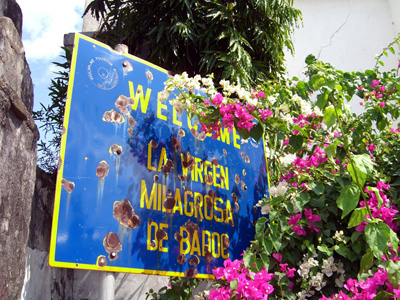 Estimated
to be 400 years old, the revered image of La Virgen Milagros de Badoc is
enshrined and venerated in the more than 200 year old imposing brick-and-stone
baroque Catholic Church of the Parish of Saint John the Baptist in Badoc, Ilocos
Norte. Inside the church one will find the miraculous image of the Virgin Mary
with the infant Jesus wrapped in her arms.
Estimated
to be 400 years old, the revered image of La Virgen Milagros de Badoc is
enshrined and venerated in the more than 200 year old imposing brick-and-stone
baroque Catholic Church of the Parish of Saint John the Baptist in Badoc, Ilocos
Norte. Inside the church one will find the miraculous image of the Virgin Mary
with the infant Jesus wrapped in her arms.
Countless miracles
have been ascribed to the beloved image of La Virgin Milagrosa de Badoc which
have kindled and heightened the veneration and devotion of the people from the
Ilocos region for which the image was really meant. Realizing the intense and
widespread devotion, the Diocese of Laoag proclaimed the wooden image of La
Virgen Milagrosa de Badoc as the Patrones of Ilocos Norte on May 2, 1980. This
church in Badoc was the pilgrimate site for the Great Jubilee Year 2000.
Badoc is the
southernmost town of the province of Ilocos Norte and lies 40 kilometers south
of Laoag City. Being the gateway to the province from the south, it serves as
the show window of historic Ilocos Norte. The establishment of the town as a
parish in 1714 was also the approximate start of the construction of the Spanish
built Catholic church, known as the Saint John the Baptist Church. It is said
that the place of the Isneg settlement, wherein the first Spanish missionary
team also established camp, was the seat of the Christianization of the town. It
was also in the place where the church was established and where the first mass
was said by Padre de Alvarado, an Augustinian priest who was the spiritual
adviser of the expedition led by the youthful Spanish conquistador, Juan de
Salcedo. The first mass, which was celebrated on June 24, 1572, or more than two
centuries before the construction of the Catholic church, was said in
thanks-giving for the peace treaty between Salcedo and the native leaders and
was also dedicated to those who were slain in battle. It coincided with the
feast day of Saint John the Baptist, who was made Badoc's patron saint.
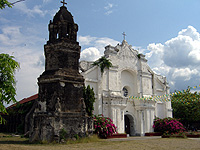
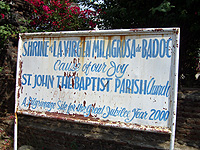
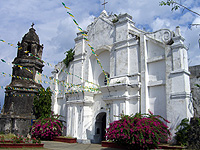
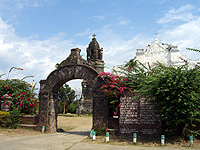
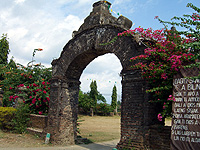

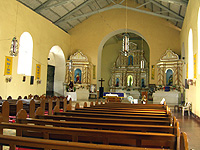
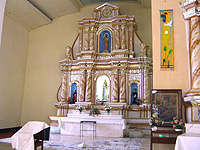
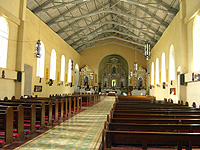

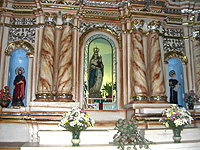
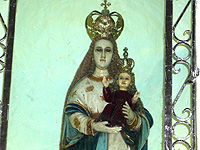
Folks recounted that the huge and imposing house of worship, made of bricks and
stones and roofed with Spanish-style corrugated clay tiles, was constructed
under the Spanish forced labor decree. It was also said that not a single drop
of water was used in the whole construction process. The concreting materials
were made purely of sugarcane juice, which the natives contributed under the
"family quota system." Now, the church, already weather-beaten but
unweakened by time and age is the sanctuary and shrine of La Virgen Milagrosa de
Badoc, because it was found in the year 1620 by Badoc and Sinait fishermen along
the shore of Lugo village. The image, encased in a wooden box, together with a
life-sized picture of Santo Cristo Milagroso, the statue of angels and one
violin, were given to the Sinait fishermen as their share from the mysterious
discovery, Since, then, the Sinait Catholic church has become the shrine of the
Santo Cristo Milagroso.
 Estimated
to be 400 years old, the revered image of La Virgen Milagros de Badoc is
enshrined and venerated in the more than 200 year old imposing brick-and-stone
baroque Catholic Church of the Parish of Saint John the Baptist in Badoc, Ilocos
Norte. Inside the church one will find the miraculous image of the Virgin Mary
with the infant Jesus wrapped in her arms.
Estimated
to be 400 years old, the revered image of La Virgen Milagros de Badoc is
enshrined and venerated in the more than 200 year old imposing brick-and-stone
baroque Catholic Church of the Parish of Saint John the Baptist in Badoc, Ilocos
Norte. Inside the church one will find the miraculous image of the Virgin Mary
with the infant Jesus wrapped in her arms. 










